Improving your keyword rankings in search isn’t as straightforward as it once was.
With all of the recent Google algorithm changes we have seen, traditional tactics like keyword research and targeting, page tagging optimization, and on-page content updates don’t have the impact that they used to.
More importantly, every website is unique. This means that using a certain tactic doesn’t guarantee a specific result for your website.
The same change could impact websites differently, which is why it’s important to make continuous improvements, test new strategies, monitor performance, and adjust as needed.
In today’s evolving search landscape, we need to think beyond traditional keyword ranking factors and look at the big picture.
This involves focusing on the overall experience of a website, optimizing content for both users and search engines, building inbound links the right way, and much more.
Here are several ways to improve your keyword rankings in Google by looking at your site more holistically.
1. Measure Your Rankings
The first, and probably the most obvious, place to start is measuring your rankings.
Without having a solid understanding of your baseline keyword performance, you won’t know how far you’ve come and how much you’ve improved.
I’d highly suggest exporting all of this valuable keyword data and keeping it on file to reference in the future.
Some of us may have learned the hard way, but you never know when things will change in any given tool – whether it’s how the data is reported, what information we have access to, etc.
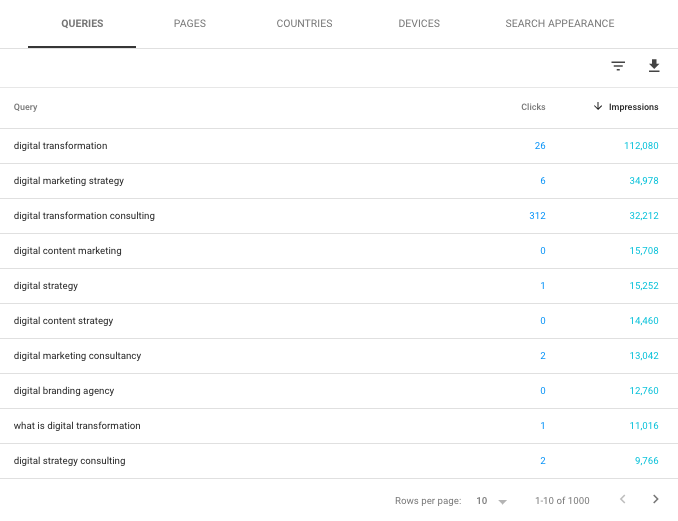
Export keyword data from Google Search Console and landing page traffic (organic and total) from Google Analytics.
Analyzing this data will give you a good idea of:
- What your most valuable keywords/landing pages are.
- Where the most immediate opportunities for improvement are.
- What keywords/landing pages are underperforming.
As far as the top areas for improvement, focus on keywords that are ranking in positions 5 through 15 (where you’re teetering at the bottom of Page 1 or top of Page 2 on Google).
For these terms, ranking at the top of the first page on Google is very likely, and will give you some quick wins to share with your client or boss.
2. Target the Right Keywords
To ensure your keyword targets are aligned with overarching business objectives and offer real value, it’s important that you understand both the search intent behind them and the difficulty of ranking.
While terms have a particular meaning to you, they could take on an entirely different meaning in Google and vice versa.
Knowing the type of intent, whether it’s informational/educational, transactional or navigational, will help you understand what stage users are at in the sales funnel.
Doing a thorough SERP analysis will be essential. Look at what’s currently ranking in the top search result for your core keyword targets including:
- Related searches
- People also ask
- Google autocomplete suggestions
- Other advanced search features
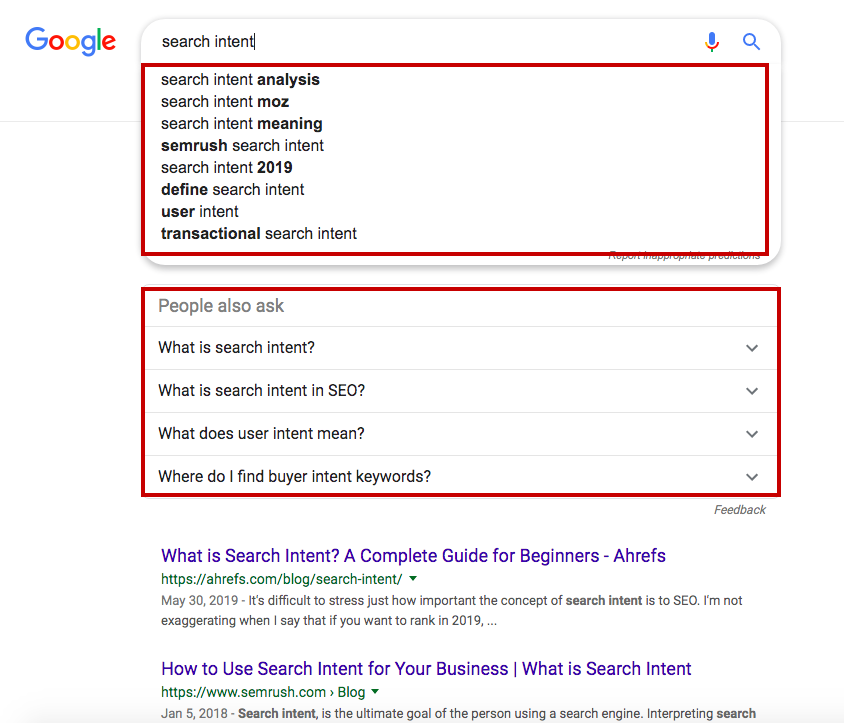
Knowing what is required to rank for a particular keyword will help you draw conclusions about what content development efforts will be required and come up with a plan for creation.
SEMrush’s SEO Content Template is really great for this type of analysis.
You simply enter a keyword, and the tool will analyze what’s showing up in Google’s top results to provide recommendations for SEO-friendly content.
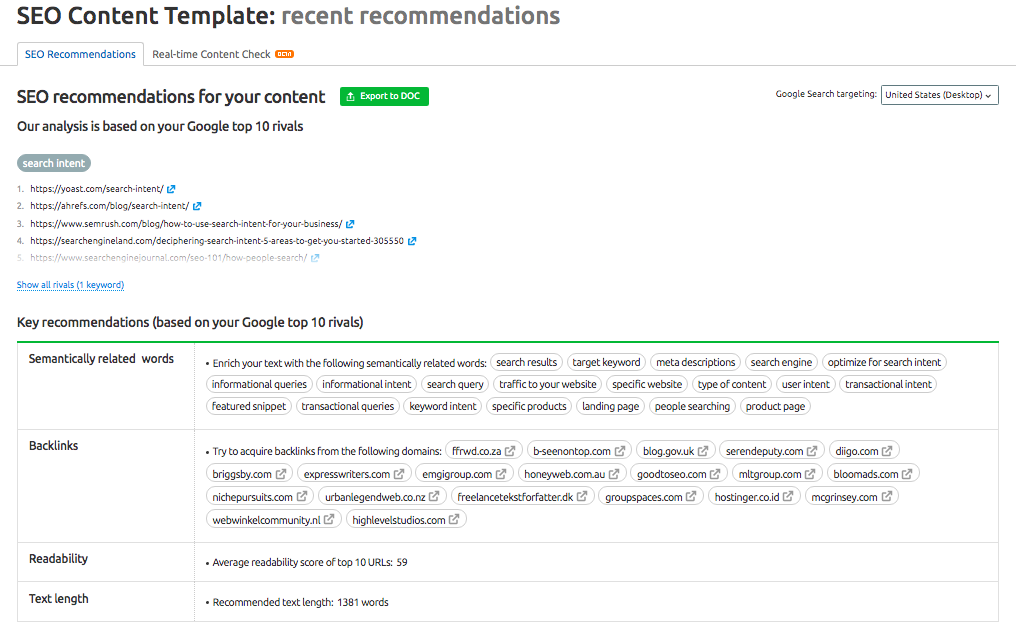
Cross-referencing your organic keyword research with paid advertising data can also help uncover new opportunities and fill gaps.
Don’t ignore long-tail queries. While they may have lower search volume, you could be missing out on extremely targeted audiences that are ready to buy.
3. Fix Technical Issues
Setting a solid foundation for your website involves resolving any technical issues that may diminish your organic keyword visibility.
Site pages should be both easily found and navigated by search engines and users.
If your website is difficult for users to navigate and search engines to crawl, your keyword rankings will likely be negatively impacted.
And, vice versa – if you’re website is intuitive for both users and Google, your rankings are bound to see positive increases.
Make sure that your site has a solid website structure, fix any broken links, and resolve any duplicate content issues.
Conducting a thorough technical SEO audit is necessary to ensure all priority technical issues are addressed.
4. Focus on the User Experience
User experience and brand equity are important when it comes to driving organic search visibility.
While user experience may not be a direct responsibility of a search engine marketer, it’s important that user experience and SEO work together.
Here are some of the key elements that present an opportunity to improve UX and SEO:
- Keyword research: Confirm that you’re targeting keywords that have the right search intent and are aligned with the language that your target audiences use.
- Page tagging: Ensure page tagging is engaging and encourages clicks to your website (title tags, meta descriptions, main headings).
- Content optimization: Keep users on the page and provide them with another logical destination or next step. This involves everything from the navigation to the copy, internal cross-linking, and call-to-actions on your site.
- Page speed: Give users the content they are requesting quickly and seamlessly across devices. Compress images, be mobile-friendly, clean up your code, and speed up your server.
5. Optimize for Users & Search Engines
Many of us get so fixated on optimizing content for Google that we forget what the end game is – to reach a highly targeted set of humans.
While search engines and humans have a different way of reading and digesting content, there are certainly commonalities that will help ensure we are creating content with both in mind.
Both robots and humans want us to be:
- Be clear and concise.
- Provide accurate information.
- Avoid jargon.
- Cover related subtopics.
This is important to keep in mind from the start of your content creation process.
As we are thinking about ways to make our content easier to read for both users and search engines, header tags are key.
Not only will proper header tags improve the overall readability of your content, but they will also ensure search engines can follow the hierarchy of what is most important on the page.
Images should also be a consideration, as providing more engaging imagery can make all the difference for users. It also presents the opportunity to further optimize for search engines through ALT text and file naming.
6. Create Eye-Catching & Engaging Titles
Dare I say that title tags are the most important SEO element of a webpage?
Not just because it’s an SEO best practice, but also because it’s the first thing that users see in search results and on social media.
The title tag is your biggest opportunity to catch the eyes of a user and encourage them to click into the page.
Determine the page that you want to rank for the keyword target at hand, and then figure out a way for your title to stand out from all the others.
Yes, the keyword target should be included towards the beginning of the title tag, but how else can you encourage users to click?
BuzzSumo analyzed 100 million headlines and learned that:
- Emotional headlines drive interactions.
- Curiosity and voyeurism gain engagement.
- List posts and the number 10 in headlines are extremely powerful.
While meta descriptions don’t have a direct impact on rankings, they should work closely with your title tags. Incorporate the keyword if possible, as well as a clear call-to-action for users.
The goal of your title tag and meta description should be to explain the benefit to users, provoke emotion, and trigger engagement, all while applying SEO best practices.
7. Stay on Top of Algorithm Updates
Why should you care about Google’s most recent algorithm updates?
Because good SEO professionals stay on top of that stuff. Among many other reasons, it helps ensure your keyword rankings are not only steady, but they’re constantly improving.
Knowing when an algorithm update first hit and when it officially ended is useful for tracking purposes, and will allow you to trace back keyword and traffic fluctuations to the root cause.
This will help you uncover potential reasoning for how/why a site was hit by an update, or certain keyword rankings and pieces of content that may have been impacted by it.
As we have experienced recently, when multiple algorithm updates happen over a short stretch of time, figuring out why certain site changes have occurred and analyzing the impact of a specific update is extremely difficult.
8. Provide Answers to the Questions People Are Asking
It’s clear that Google is on a mission to provide users with answers.
Just look at all of the new and increased SERP features we have seen over the past couple of years:
- Featured Snippets (or Answer Boxes).
- People Also Asked
- Knowledge Cards
- Dictionary Definitions.
- And the list goes on.
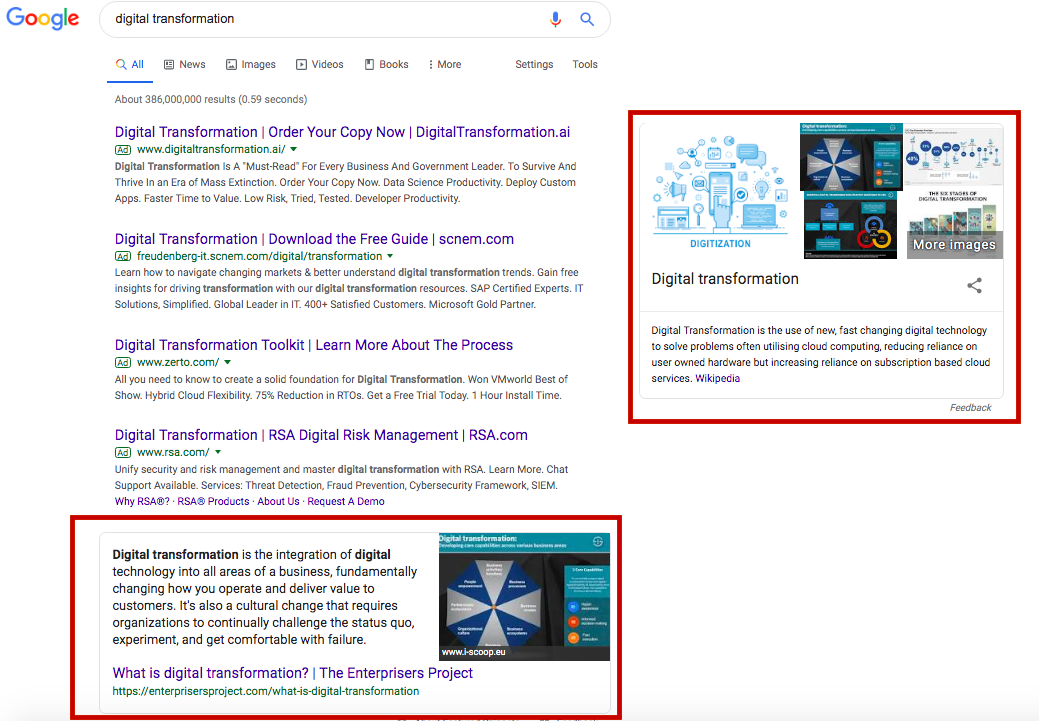
Optimizing for Featured Snippet results and People Also Asked features around your priority keyword targets is now becoming an essential part of SEO strategy.
While there is certainly a great deal of debate over the direct value that ranking in “position zero” of search results offers a business, ultimately, I pose this question:
Would you rather have your competitor rank in the Answer Box for that search query?
As far as we know, the Featured Snippet result isn’t going away anytime soon, and not ranking in it could mean lost visibility to your competitor, or even your “frenemy” Google.
9. Build Valuable Inbound Links
Start by looking for opportunities on your own website to cross-link to assets from keyword-rich anchor text. This will help drive users to relevant content, and build keyword association.
Unfortunately, crafting a strong internal link strategy is only half of the battle. The other half is generating highly authoritative and valuable inbound links from third-party websites.
This can seem overwhelming, but there are some key tactics to hone in on:
- Create link-worthy content that is based on your keyword research and analysis of what is ranking in top search results to help generate inbound links and improve keyword rankings.
- Monitor mentions of your brand for some quick-win opportunities to gain a inbound link from websites that are already talking about you.
- If you want other websites to link to you, remember to link to other websites. You only get as much as you give.
- Leverage social media to support link building. Interact with your targets beforehand to help build relationships prior to reaching out about a link building opportunity.
These are just a few tactics to get you started; however, there are certainly more advanced link building tactics to be successful in today’s extremely competitive landscape.
10. Promote Your Content Strategically
I mention this briefly above, but it’s also important to leverage non-SEO channels in an effort to drive visibility to your assets and support your link building efforts.
The more eyes that you get on your content, the more opportunity you have to:
- Generate inbound links.
- Drive social media shares.
- Gain traction to the piece.
- Rank better.
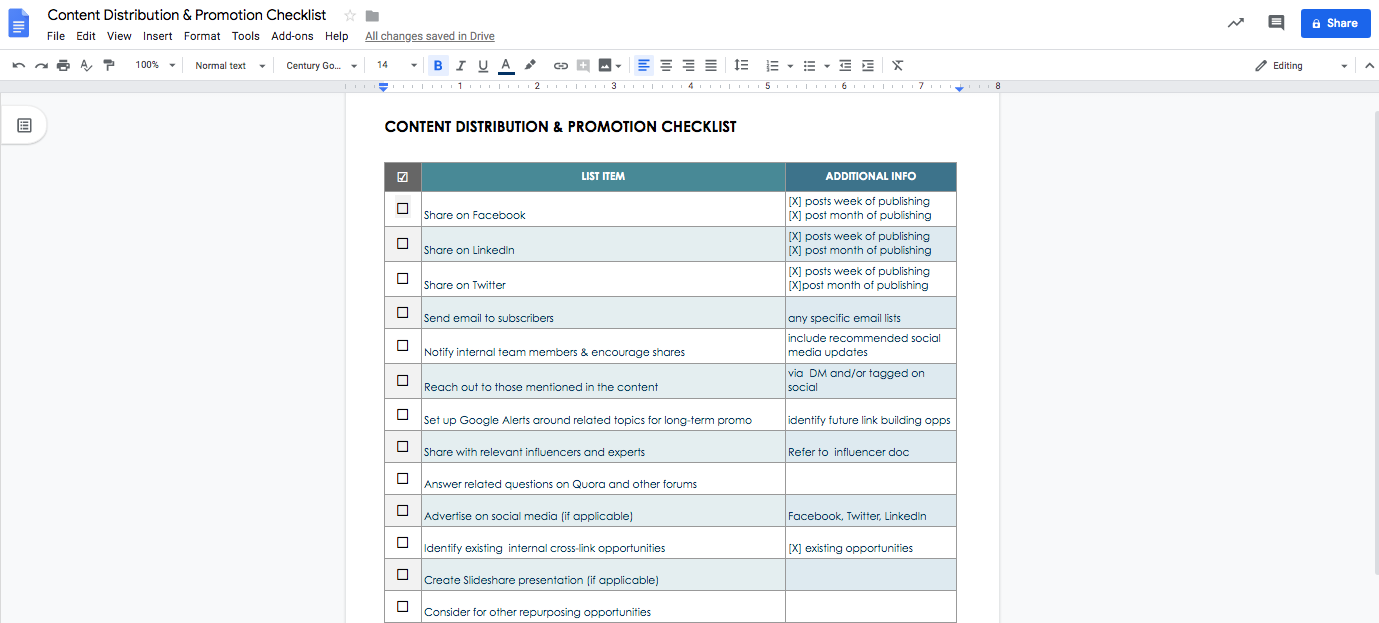
While different promotional tactics may apply to different types of content, creating a checklist is always helpful. This way, when it comes time to promote an asset, you have a list of all possible tactics.
This could include:
- Distributing across social media channels.
- Pushing out an email to subscribers.
- Letting internal team members know to encourage shares.
- Reaching out to those mentioned in the asset.
- Setting up Google Alerts to monitor conversations around the topic.
- Sharing directly with certain experts or influencers.
- Answering related questions on Quora, or other forums.
- Advertising on social media.
- Identifying existing internal cross-link opportunities.
- Creating a SlideShare presentation, or repurposing the asset in other forms.
11. Continuously Optimize & Improve Content
It doesn’t stop there. We know that search engine results are constantly changing, and this means that you need to make continuous optimizations and improvements to your content.
For example, just because you’ve gained the Featured Snippet result for a particular keyword or phrase, does not mean that you will stay there.
Refreshing your content will ensure that you’re offering users with the best (and up to date) information, and driving increased keyword visibility.
If content is out of date, you will likely see the associated keyword rankings decline.
On the other hand, if you’re always looking for opportunities to refresh your content and provide users with the best material, you will likely see keyword ranking increases.
Content optimization should never be one-and-done, especially if you aren’t seeing the results that you want. If an asset isn’t ranking, re-optimize it for relevance, search intent, engagement, and readability.
Your goal should be to offer users a piece of content that is better than everything else being displayed for the given query.
The concept that, “if it’s not broke, don’t fix it” certainly applies here.
For example, if you are ranking in the first position on Google for an extremely competitive and highly searched for keyword, you don’t want to risk losing that.
In that case, I would not recommend changing the title tag or anything that could have a negative impact.
However, there could be opportunities to make the asset that is ranking more conversion-friendly and encourage users to stay on your site.
Final Thoughts
Don’t get me wrong – I’m not saying that tactics like page tagging and on-page content optimizations aren’t important anymore. But, it’s also essential that SEOs look at the 10,000-foot view of their website.
If you aren’t driving the results you need from certain ranking tactics, it may be time to take a step back and look at your website more holistically.
And, remember, it may take some testing, failing and testing some more to find the tactics that will have the biggest impact on your unique site.
Hopefully, this article has provided you with some new ideas and considerations to help improve your keyword rankings on Google.
More Resources:
Image Credits
In-Post Image: Created by author, August 2019
All screenshots taken by author, August 2019
